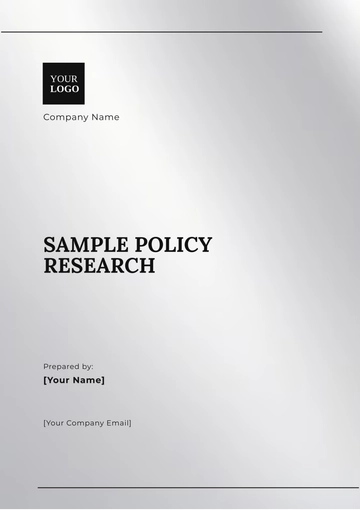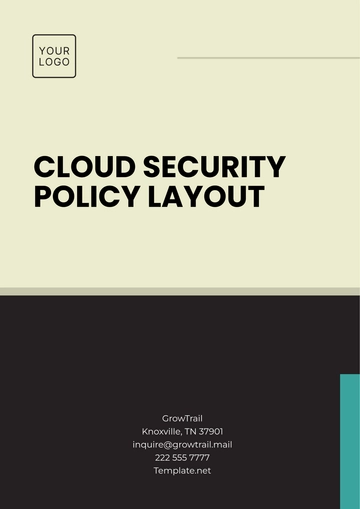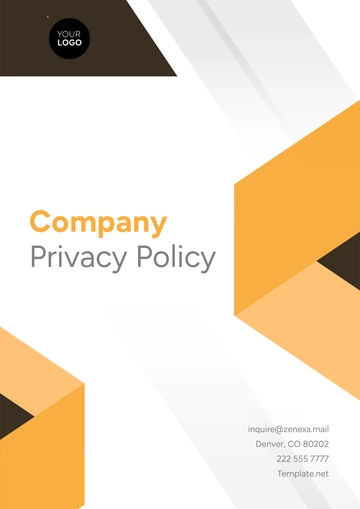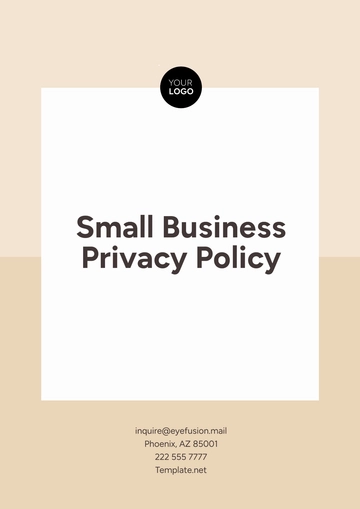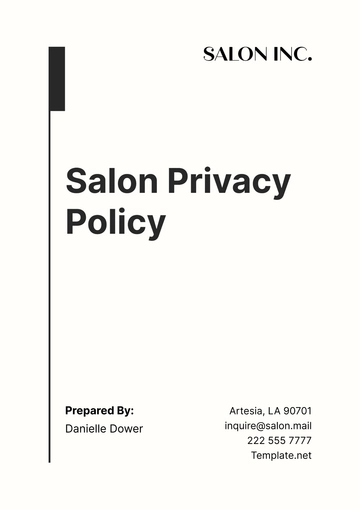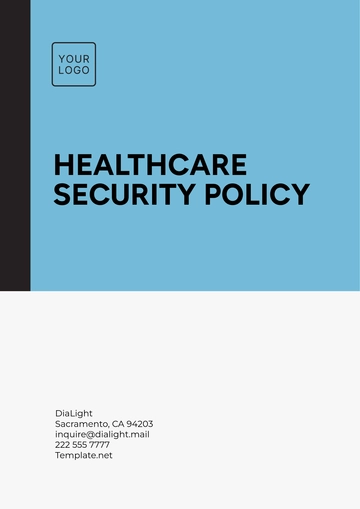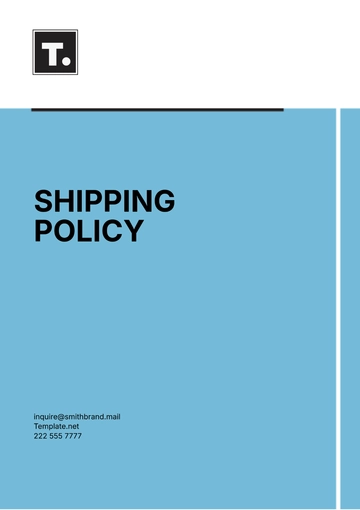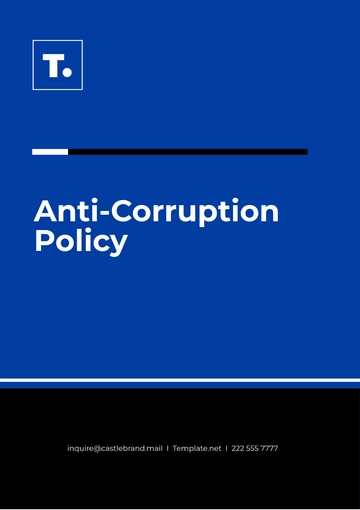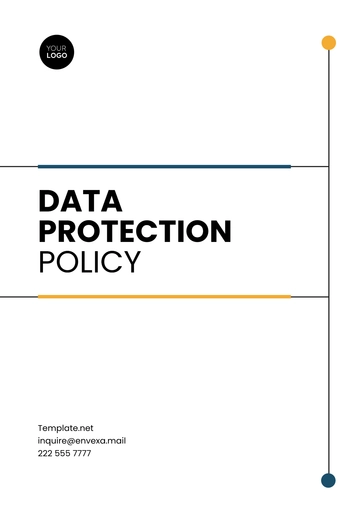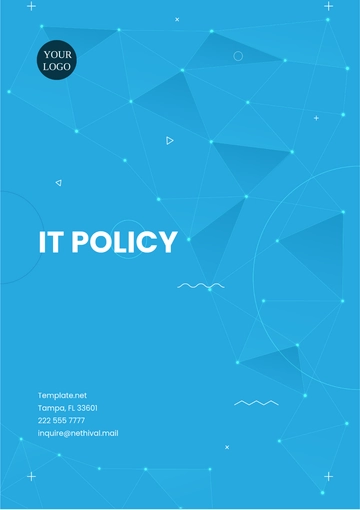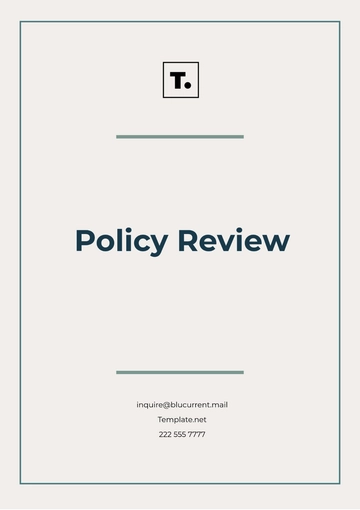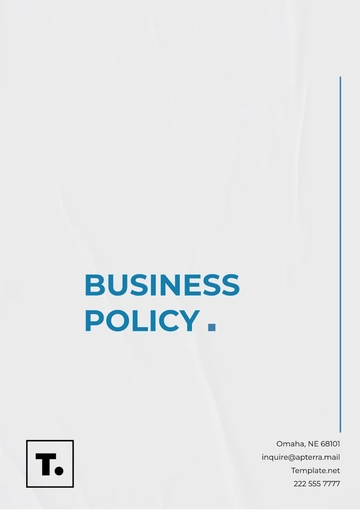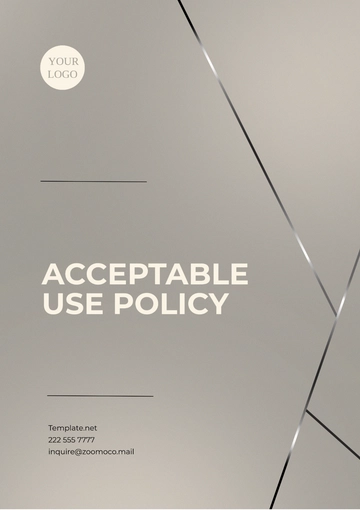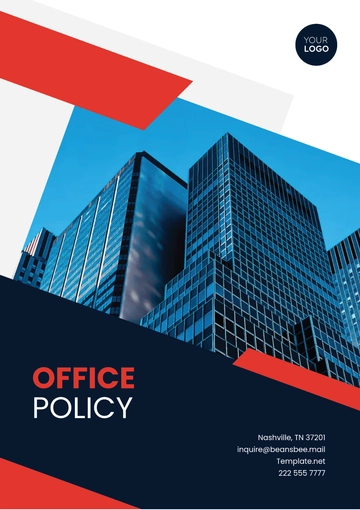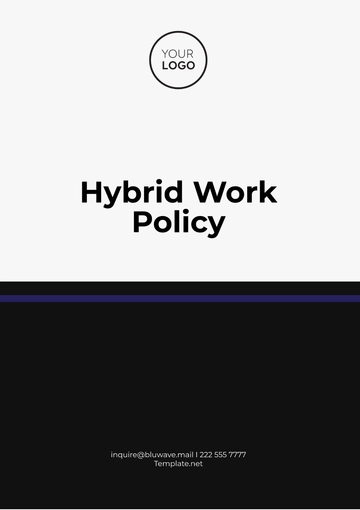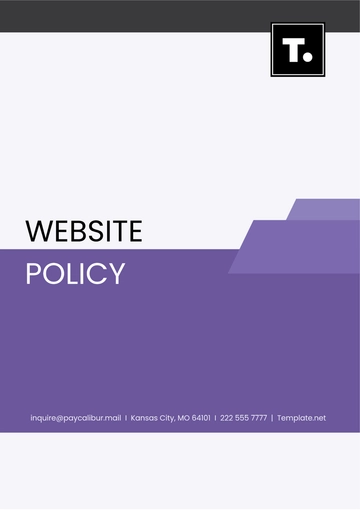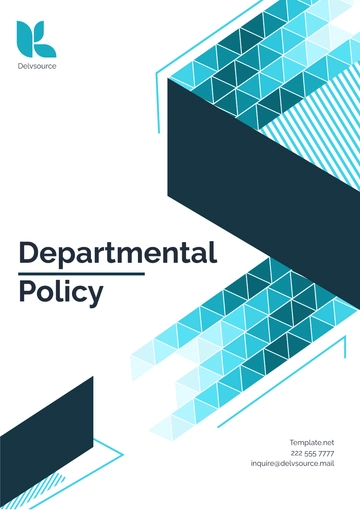Free Administration Document Classification Policy
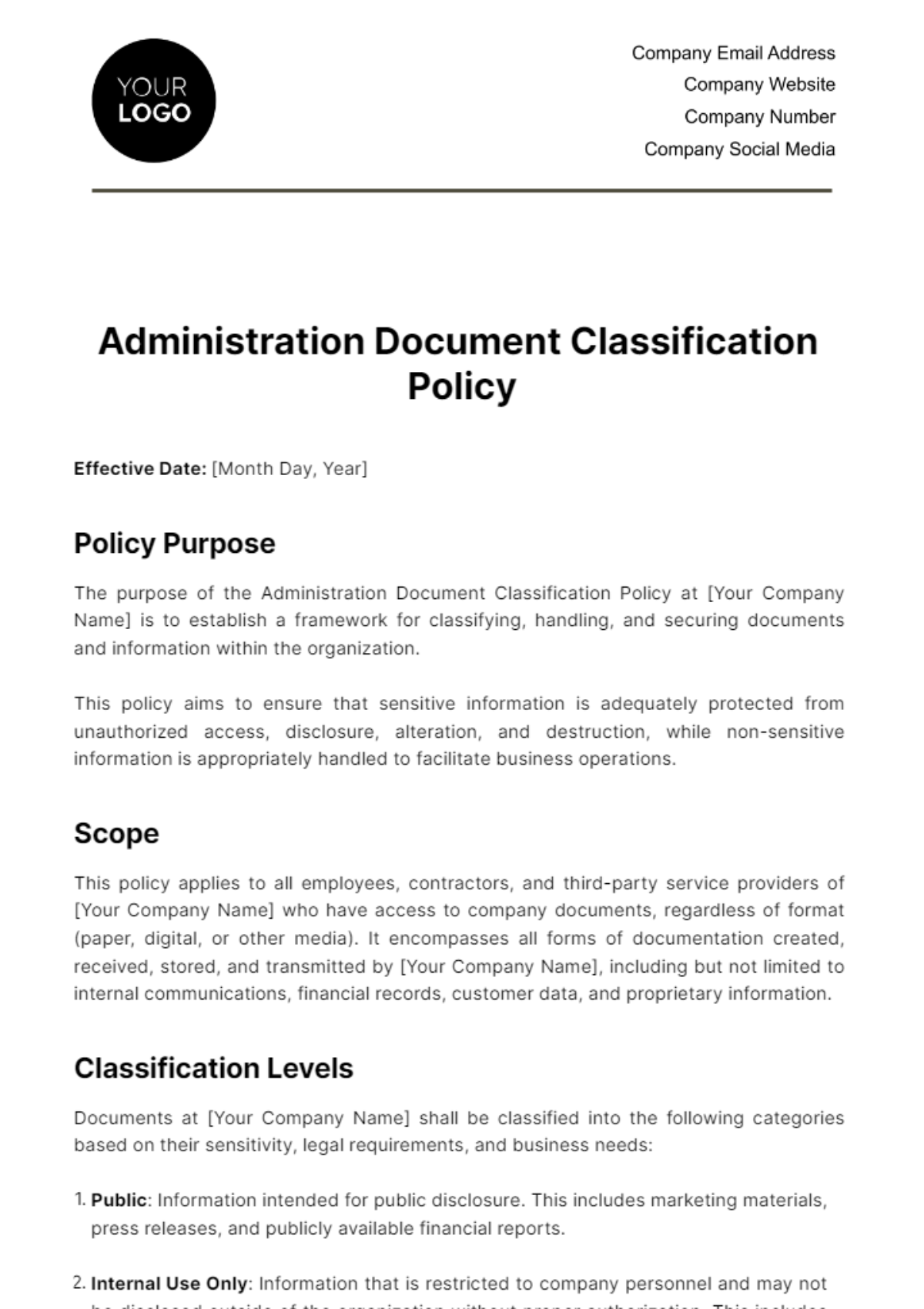
Effective Date: [Month Day, Year]
Policy Purpose
The purpose of the Administration Document Classification Policy at [Your Company Name] is to establish a framework for classifying, handling, and securing documents and information within the organization.
This policy aims to ensure that sensitive information is adequately protected from unauthorized access, disclosure, alteration, and destruction, while non-sensitive information is appropriately handled to facilitate business operations.
Scope
This policy applies to all employees, contractors, and third-party service providers of [Your Company Name] who have access to company documents, regardless of format (paper, digital, or other media). It encompasses all forms of documentation created, received, stored, and transmitted by [Your Company Name], including but not limited to internal communications, financial records, customer data, and proprietary information.
Classification Levels
Documents at [Your Company Name] shall be classified into the following categories based on their sensitivity, legal requirements, and business needs:
Public: Information intended for public disclosure. This includes marketing materials, press releases, and publicly available financial reports.
Internal Use Only: Information that is restricted to company personnel and may not be disclosed outside of the organization without proper authorization. This includes internal policies, procedures, and training materials.
Confidential: Information that if disclosed unauthorizedly could cause harm to [Your Company Name] or its stakeholders. This includes financial data, strategic plans, and customer information.
Restricted: Information that if disclosed unauthorizedly could cause significant harm to [Your Company Name], its stakeholders, or national security. This includes classified projects, legal documents, and sensitive personal data.
Responsibilities
The Administration Document Classification Policy delineates specific responsibilities for various roles within [Your Company Name] to ensure the effective implementation and adherence to the policy guidelines. These roles and their responsibilities are detailed as follows:
Employees: All employees are required to familiarize themselves with the document classification levels and apply these classifications accurately to all documents they handle. Employees must respect the confidentiality and access restrictions of documents according to their classification level.
Department Heads: Department Heads play a critical role in the enforcement of this policy. They are responsible for ensuring that all team members within their department are adequately trained on the policy's provisions and understand how to classify and handle documents appropriately. Department Heads must also monitor compliance and address any deviations from the policy promptly.
IT Department: The IT Department is tasked with providing the technical infrastructure and tools necessary to support the classification, storage, transmission, and destruction of documents in a secure manner. This includes implementing access controls to ensure that only authorized individuals can access classified information, encrypting sensitive data in transit and at rest, and providing secure storage solutions.
Security Department: The Security Department oversees the overall governance of the document classification policy. This includes conducting periodic audits to ensure compliance with the policy, investigating any incidents of non-compliance or data breaches, and recommending improvements to security practices and the policy itself.
Compliance Officer: The Compliance Officer ensures that [Your Company Name]'s document classification practices adhere to legal and regulatory requirements. They are responsible for staying abreast of changes in legislation that affect document handling and for updating the policy as necessary. The Compliance Officer also liaises with external auditors during compliance audits and reviews.
Executive Management: Executive Management is responsible for endorsing the Administration Document Classification Policy and providing the necessary resources for its implementation and maintenance. They must also foster a culture of security and compliance within the organization by demonstrating a commitment to the policy and holding all levels of management accountable for its enforcement.
Collaborative Compliance:
Collaboration across departments and levels of authority within [Your Company Name] is essential for the successful implementation of the Administration Document Classification Policy. Each member of the organization, from entry-level employees to the CEO, plays a vital role in protecting the integrity, confidentiality, and availability of company documents. Regular training, clear communication, and a transparent culture of compliance are key to ensuring that all personnel are engaged and accountable.
Implementation
Training and Awareness: All employees, contractors, and third-party service providers associated with [Your Company Name] are required to undergo comprehensive training on the Administration Document Classification Policy upon their initial engagement and subsequently on an annual basis. This training program is designed to ensure that all relevant parties are fully aware of their responsibilities under this policy, understand the different levels of document classification, and are proficient in the correct procedures for classifying, handling, securing, and disposing of documents.
Document Classification and Labeling: Upon creation or receipt, every document within the scope of [Your Company Name]'s operations must be immediately classified according to the established classification levels outlined in this policy. The responsible individual must affix a clear and conspicuous label that indicates the document's classification level. These labels should be placed in a prominent position to ensure they are easily visible to anyone handling the document.
Access Control and Security Measures: Access to classified documents will be strictly governed by the principle of least privilege, which ensures that individuals are granted access only to the information necessary to perform their job functions. The IT Department will implement robust access control mechanisms to enforce this principle. These mechanisms may include user authentication, role-based access control, and audit logs to monitor access to sensitive documents.
Monitoring and Compliance: Ongoing monitoring of compliance with the Administration Document Classification Policy will be conducted by the Security Department. This will include regular audits of document handling practices, access controls, and adherence to classification protocols. Any identified non-compliance will be addressed promptly, including the provision of additional training, adjustments to security measures, or disciplinary action, as appropriate.
Enforcement
Disciplinary Actions: [Your Company Name] regards the security and integrity of its documentation as paramount. Accordingly, any violations of the Administration Document Classification Policy will be met with strict disciplinary measures. These measures may range from formal warnings to mandatory retraining, suspension, and, in cases of severe or repeated breaches, termination of employment. The specific disciplinary action will be determined based on the nature and severity of the violation, the individual's history of prior offenses, and the impact of the violation on [Your Company Name] and its stakeholders.
Legal and Financial Repercussions: Violations that result in unauthorized disclosure, alteration, or destruction of classified documents may also subject the violator to legal action and financial liability. [Your Company Name] reserves the right to pursue recourse in civil court to recover damages and to seek prosecution under applicable criminal laws. Individuals may be held personally liable for any financial losses incurred by [Your Company Name] or its clients due to such violations.
Policy Review and Revision
To ensure the Administration Document Classification Policy remains effective and aligned with current legal, regulatory, and operational requirements, it will undergo a comprehensive review on an annual basis. Following each review, the policy may be revised to incorporate necessary updates. These revisions will address any identified gaps, improve clarity, and introduce enhancements to document classification and handling procedures.
[Your Company Name] is committed to the security and proper handling of all documents and information within the organization. Compliance with this policy is mandatory for all employees, contractors, and third-party service providers.
Approved By:
[Your Name]
[Job Title]
[Month Day, Year]
- 100% Customizable, free editor
- Access 1 Million+ Templates, photo’s & graphics
- Download or share as a template
- Click and replace photos, graphics, text, backgrounds
- Resize, crop, AI write & more
- Access advanced editor
Safeguard your information with precision using the Administration Document Classification Policy Template from Template.net. This customizable template provides a structured approach to classifying and managing your organization's documents. Editable in our Ai Editor Tool, it ensures your policies are up-to-date and reflective of current standards.
You may also like
- HR Policy
- Restaurant Policy
- Company Policy
- Accounting Policies and Procedures
- Website Policy
- Privacy Policy
- Safety Policy
- School Policy
- IT and Software Policy
- Law Firm Policy
- Construction Policy
- Interior Design Policy
- Travel Agency Policy
- Education Academic Policy
- Security Policy
- Real Estate Policy
- Expense Policy
- Software Policy
